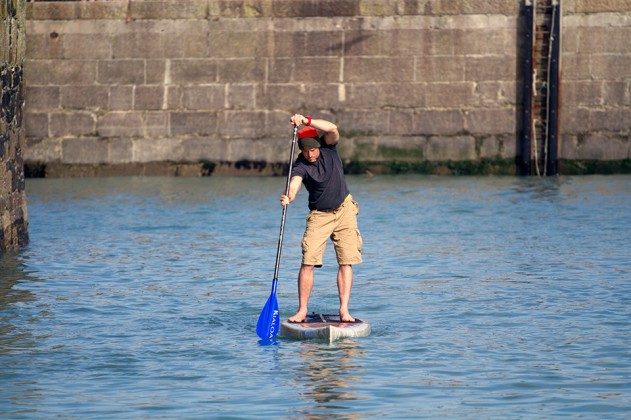PADDLE SCIENCE #3 –
SHOULDERS AND SUP
Photos – Nick Lloyd
If you’ve ever sustained a shoulder injury, you’ll know just how quickly it can stop you from getting out on the water. Shoulder injuries can commonly affect SUPers and are typically caused by the repetitive loading paddling brings.
The shoulder is the most mobile joint in the body and allows you to move through a huge range of movement, far greater than any other joint in your body. However, as the shoulder is so mobile, maintaining stability at the shoulder is paramount. Shoulder stability is mainly provided by four rotator cuff muscles and their tendons which hold the head of the humerus into the shoulder socket: the infraspinatus, supraspinatus, subscapularis and teres minor. When moving, the strength and balance between these muscles is critical to ensure that the humeral head remains central within its socket. However, habitual posture and repetitive movement patterns can lead to an imbalance between the rotator cuff muscles. If the muscles become excessively tight or change in strength, it can cause the humerus to deviate away from its central position resulting in shoulder pain and injury on movement.
SHOULDER IMPINGEMENT
Shoulder impingement is one of the biggest shoulder injuries and is extremely common in swimmers, surfers and SUP-ers. Typically, it occurs when the tendons of the rotator cuff muscles become trapped and compressed against the acromion or roof of the shoulder, commonly affecting the supraspinatus tendon. A small fluid filled sac known as a bursa, sits between the rotator cuff and the acromion, enabling the shoulder to move and glide comfortably in different directions. When the shoulder is raised, the space between the rotator cuff and the acromion becomes smaller yet normally there is adequate space for this to occur without pain. However, repetitive paddling or overhead movement can lead to irritation and inflammation of both the rotator cuff and the bursa. This consequently reduces the space available within the shoulder and compresses the rotator cuff, leading to injury and pain.
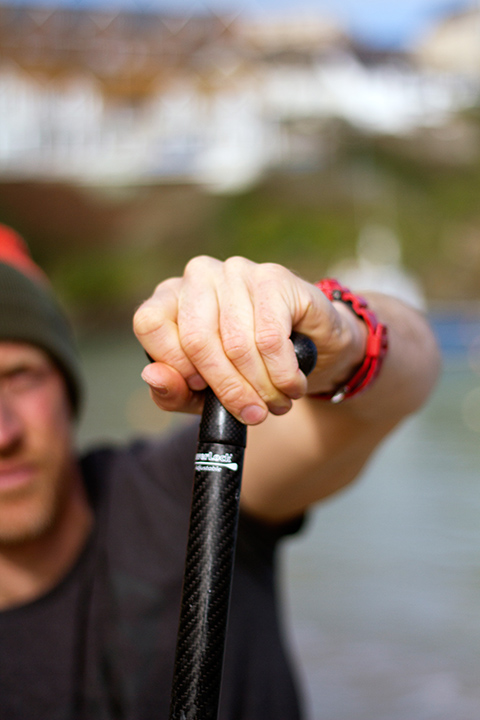
Internally rotated – bad
In similarity to surfing and swimming, paddling encourages us to internally rotate at the shoulder. To understand this movement, place your arm out in front of you with your palm facing down to the floor. Leading with your thumb, turn your hand down to the floor – this is internal rotation. Now, leading with your little finger, turn your hand down to the floor – this is external rotation. Every time you paddle, you internally rotate again and again which essentially closes the shoulder joint down, reducing the amount of space available for the rotator cuff tendons. Notably, repetitive contraction of the muscles which internally rotate the shoulder can result in muscle tightness. This can lead to a rotator cuff muscle imbalance preventing the humerus from sitting centrally within the shoulder socket. Furthermore, as these muscles tighten they will naturally begin to hold the shoulder in an internally rotated position.
This means, that even when you’ve stopped paddling and are off the water, your shoulder will sit in an internally rotated position, predisposing you to shoulder impingement.
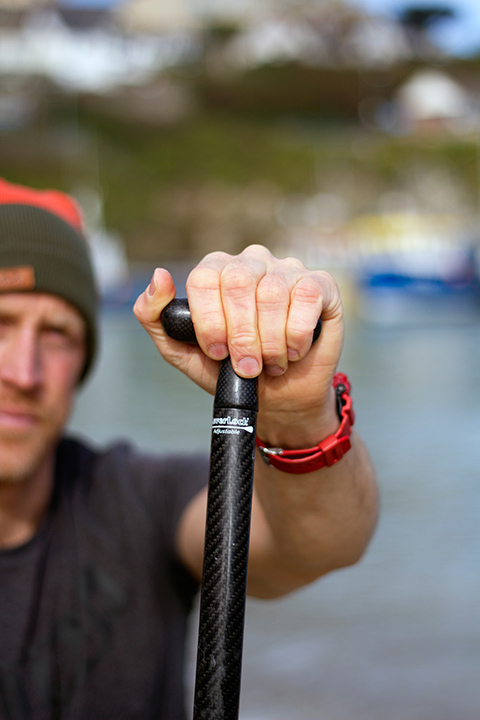
Externally rotated – good
Shoulder impingement generally has a gradual onset which becomes worse with increased paddling. Typically, it leads to pain as you lift your arm beyond a ninety degree angle above your head. You may also notice shoulder pain when pushing down through your arms as you climb back onto your board. Rest from repetitive paddling is a critical element of the initial treatment as increased activity can further damage and aggravate the problem. Strengthening the rotator cuff and shoulder blade muscles together with muscle stretching is also important to promote stability and muscle balance. To help prevent it try the following:
1. Make sure that you do not lift your top arm higher than eye height when paddling. Paddle length is therefore critical so that you do not repeatedly lift your shoulder much greater than ninety degrees.
2. Focus on opening or externally rotating your shoulders a little when paddling. In other words, when you place your top hand on the T-grip, make sure that your thumb isn’t angled downwards towards the board too much. Instead, aim to keep a flatter palm so as to open up the shoulder joint.
3. Stretch your pec muscles. This will help to correct any excessive internal rotation at the shoulder.
4. Strengthen your external rotator muscles (teres minor and infraspinatus) to help counteract any increased pull from the internal rotator muscles due to muscle tightness.
“ To promote mobility, actively move your shoulder through its entire range of movement and aim to stretch your neck and shoulder muscles before and after every SUP session ”
ROTATOR CUFF TEAR
SUPing places a considerable load on the rotator cuff muscles which can predispose them to rotator cuff tears. Often, muscle tears are preceded by shoulder impingement as any injury to the tendons can lead to abnormal movement patterns and weakness. Tendons typically have a poor blood supply which not only reduces their ability to heal but can lead to tendon degeneration and further weakness, further exacerbated by repetitive paddling and overhead movements. Alongside pain, a rotator cuff muscle tear will typically result in a feeling of weakness at the shoulder with the severity of this weakness dependent upon the size of the tear. A partial tear will cause mild weakness whilst a complete tear may lead to a complete inability to lift the arm.
Initial treatment consists of rest, ice and anti-inflammatories. If a partial tear has occurred, rest normally enables the muscle fibres to heal on their own. Once the pain has settled, strengthening of the rotator cuff and shoulder blade stabilisers is imperative to regain shoulder stability and muscle strength. If weakness persists or if a complete cuff tear has occurred, surgical input is often required.
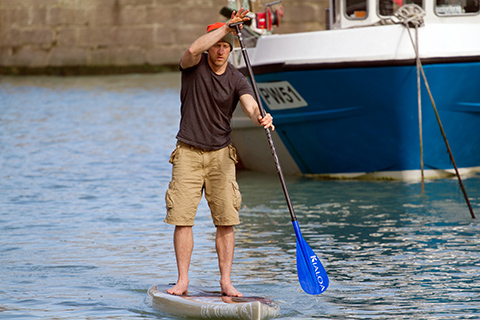
Don’t over extend during the reach phase.
ROTATOR CUFF AND BICEPS TENDINOPATHY
In simple terms, when a tendon is overused, inflammation and structural change can occur within the tendon, resulting in a tendinopathy. It can commonly affect the rotator cuff tendons, in particular the supraspinatus tendon. This is because, as you paddle, your supraspinatus repeatedly contracts to abduct your shoulder, often leading to overuse. Tendinopathy can also commonly affect the long head of biceps tendon which attaches the upper part of the biceps muscle to the bones in your shoulder. Every time you reach your paddle towards the front of the board, your biceps muscle works to extend your shoulder out in front of you. Repetitive paddling can therefore lead to overuse of this tendon, leading to pain at the front of the shoulder. To help prevent the problem from arising:
1. Make sure that your paddle is at the correct height so that you don’t have to lift your top arm too high.
2. Do not over extend in the reach phase when paddling.
3. Give yourself adequate recovery time between SUP sessions.
4. Monitor how your shoulder feels the day after paddling. This is because tendons can be relatively pain free during exercise but can begin to grumble up to twenty-four hours after overusing them.
MUSCLE TIGHTNESS
Muscle tightness can occur in numerous muscles in and around the neck and shoulder causing the development of tight bands or ‘trigger points’. Chronic tension and muscle overuse can affect numerous muscles when SUPing. When paddling, the rhomboids retract and help to support the shoulder blade. Meanwhile, the trapezius which attaches from the neck to the top of the shoulder stabilises the neck and shoulder when paddling. Both muscles require a high level of endurance when paddling and due to repetitive loading can fatigue and cramp, especially when paddling long distances. Tightness at the pec muscles is also common, leading to aching or discomfort at the front of the chest.
Typically, if you feel an overactive muscle, you’ll commonly be able to find a tight knot or band within the muscle. These tight spots can create localised aching and referred pain. As nerves run through muscles, any muscle tightness can also cause nerve impingement leading to pain referral down the arm or into the hand and fingers often accompanied by a burning sensation, pins and needles and numbness. To target and overcome tight muscles consider the following:
1. Make sure that you engage your lats and core when paddling to help generate the power required by rotating through the mid-back and trunk during the power phase. This will stop you from relying on your smaller muscles which will fatigue more quickly.
2. Stretch your rhomboids, pecs, lats and neck muscles after paddling – particularly if you have had a long session on the water or are feeling any muscular tightness.
3. Use heat on your muscles to help ease muscle tension following a SUP session.
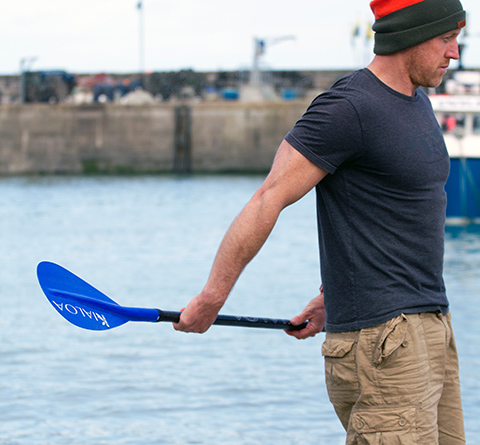
A good stretch for pecs and biceps, raise the paddle up behind your back.
If a shoulder injury or pain does occur, make sure that you don’t ignore or neglect it as continuing to paddle can further aggravate and worsen any injury. Maintain your shoulder health by giving your shoulder adequate rest and spend some time off the water gently stretching and strengthening
your shoulder.
To generate the most efficient and effective paddle stroke, maintaining both mobility and stability at the shoulder girdle is critical. To promote mobility, actively move your shoulder through its entire range of movement and aim to stretch your neck and shoulder muscles before and after every SUP session. Also seek to maintain muscular balance by regularly strengthening the rotator cuff muscles. This will help to stave off and prevent shoulder injuries keeping your shoulders healthy, mobile and strong. SUP
Kate is a physiotherapist and standup paddler. www.newquayphysio.co.uk

